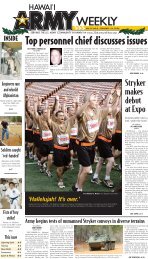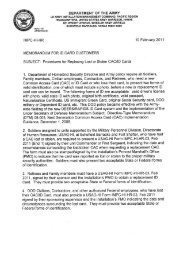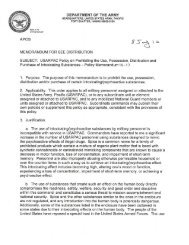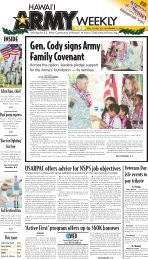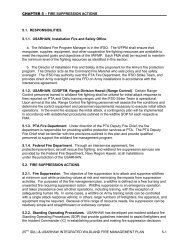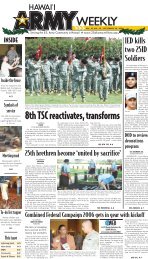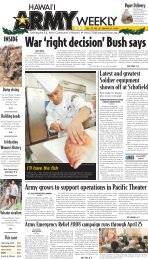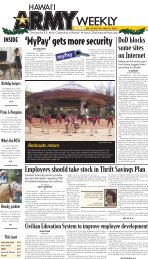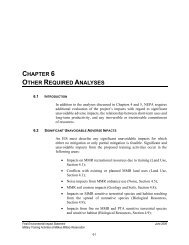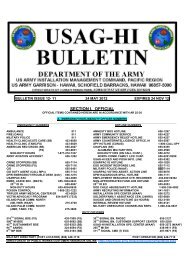Cover, Executive Summary, Table of Contents - U.S. Army Garrison ...
Cover, Executive Summary, Table of Contents - U.S. Army Garrison ...
Cover, Executive Summary, Table of Contents - U.S. Army Garrison ...
You also want an ePaper? Increase the reach of your titles
YUMPU automatically turns print PDFs into web optimized ePapers that Google loves.
This page intentionally left blank
FINAL PROGRAMMATIC ENVIRONMENTAL IMPACT STATEMENT<br />
Modernization <strong>of</strong> Training Infrastructure and Construction and Operation <strong>of</strong> an Infantry Platoon Battle<br />
Area (IPBA) at Pōhakuloa Training Area (PTA), Hawai‘i<br />
Abstract<br />
This Draft Programmatic Environmental Impact Statement (EIS) addresses the proposed modernization <strong>of</strong><br />
training infrastructure at Pōhakuloa Training Area (PTA), Hawai‘i. The lead agencies for this effort are<br />
the U.S. <strong>Army</strong> Pacific (USARPAC) and the U.S. <strong>Army</strong> <strong>Garrison</strong>-Hawaiʻi (USAG-HI). This EIS has been<br />
developed in accordance with the National Environmental Policy Act (NEPA) and implementing<br />
regulations issued by the Council on Environmental Quality (CEQ, 40 Code <strong>of</strong> Federal Regulations<br />
[CFR] Parts 1500 to 1508) and the <strong>Army</strong> (32 CFR Part 651).<br />
The <strong>Army</strong>’s Proposed Action involves modernizing training ranges, training support infrastructure (e.g.,<br />
roads and utilities), and training support facilities in the Cantonment Area at PTA. The analysis <strong>of</strong> this<br />
Draft Programmatic EIS addresses the broad environmental concerns related to modernization projects<br />
that could be implemented in the reasonably foreseeable future. The proposed modernization projects<br />
include requirements from the U.S. <strong>Army</strong> and the U.S. Marine Corps (USMC), another major user <strong>of</strong><br />
PTA. The first <strong>of</strong> the modernization project is the construction and operation <strong>of</strong> an Infantry Platoon<br />
Battle Area (IPBA). A detailed examination <strong>of</strong> the potential impacts for other proposed modernization<br />
projects would be conducted as part <strong>of</strong> future project-specific NEPA analysis.<br />
The major potential environmental issues discussed for the proposed IPBA are associated with the<br />
possible impacts to air quality, cultural sites, and threatened and endangered species; encountering<br />
munitions and explosives <strong>of</strong> concern (MEC); and igniting wildfires. The <strong>Army</strong> is formally consulting<br />
with the Hawai‘i State Historic Preservation Division (SHPD) and other consulting parties, and the U.S.<br />
Fish and Wildlife Service (USFWS) to determine the extent <strong>of</strong> impacts to sensitive cultural and biological<br />
resources, respectively.<br />
None <strong>of</strong> the <strong>Army</strong>’s proposed actions in this Draft Programmatic EIS involve the acquisition <strong>of</strong> additional<br />
land, training <strong>of</strong>f the current installation boundary, or increasing training over historical levels at PTA.<br />
For more information and to obtain a copy <strong>of</strong> the Draft Programmatic EIS, please visit the project Web<br />
site: http://www.garrison.hawaii.army.mil/PTAPEIS/. For further information, contact USAG-HI Public<br />
Affairs Office by phone at (808) 656-3152 Monday through Friday 9:00 a.m. to 5:00 p.m. Hawaiʻi<br />
Standard Time (HST). Written comments may be addressed to PTA PEIS, P.O. Box 514, Honolulu, HI<br />
96809. Facsimiles may be sent to (808) 545-6808. Email comments may be addressed to<br />
PTAPEIS@bah.com.
This page intentionally left blank
ACRONYMS LIST<br />
A&M Artillery and Mortar<br />
AAR After Action Review<br />
AAS Analysis <strong>of</strong> Alternatives Study<br />
AC Active Component<br />
ACC/MVM Accidents per Million Vehicle Miles<br />
ACGIH American Conference <strong>of</strong> Governmental Industrial Hygienists<br />
ACHP Advisory Council on Historic Preservation<br />
ADA American Disability Association<br />
ADNL A-Weighted Day-Night Average Sound Level<br />
ADT Average Daily Traffic<br />
AEDB-R <strong>Army</strong> Environmental Database- Restoration<br />
AGL Above Ground Level<br />
AGR Aerial Gunnery Range<br />
AHA Ammunition Holding Area<br />
AICUZ Air Installation Compatible Use Zone<br />
AIROPS Aircraft Operations Support<br />
AMRP <strong>Army</strong> Master Range Plan<br />
AOR Area <strong>of</strong> Responsibility<br />
APE Area <strong>of</strong> Potential Effect<br />
AR <strong>Army</strong> Regulation<br />
ARRA American Recovery and Reinvestment Act<br />
ARRM <strong>Army</strong> Range Requirements Model<br />
ASMEX Air-to-Surface Missile Exercises<br />
ASP Ammunition Supply Point<br />
ATC Aberdeen Test Center<br />
ATC Air Traffic Control<br />
ATCAA Air Traffic Control Assigned Airspace<br />
ATS <strong>Army</strong> Training Strategy<br />
ATSDR Agency for Toxic Substances and Disease Registry<br />
BA<br />
Biological Assessment<br />
BAAF Bradshaw <strong>Army</strong> Airfield<br />
Draft Programmatic Environmental Impact Statement i<br />
Modernization <strong>of</strong> PTA and Construction and Operation <strong>of</strong> an IPBA
BAX Battle Area Complex<br />
BCT Brigade Combat Teams<br />
BMP Best Management Practices<br />
BO Biological Opinions<br />
BOMBEX Bombing Exercise<br />
C2<br />
Command and Control<br />
CAA Clean Air Act<br />
CAB Combat Aviation Brigade<br />
CACTF Combined Arms Collective Training Facility<br />
CALFAM Combined Arms Live-fire and Maneuver<br />
CALFEX Combined Arms Live-fire Exercises<br />
CAS Close Air Support<br />
CASEX Close Air Support Exercise<br />
CATS Combined Arms Training Strategy<br />
CCD Census County Division<br />
CDNL C-Weighted Day-Night Average Sound Level<br />
CDS Container Delivery System<br />
CEQ Council on Environmental Quality<br />
CERCLA Comprehensive Environmental Responsibility, Compliance, and<br />
Liability Act<br />
CFA Controlled Firing Areas<br />
CFR Code <strong>of</strong> Federal Regulations<br />
CHPPM <strong>Army</strong> Center for Health Promotion and Preventive Medicine<br />
CLF Convoy Live Fire<br />
CMETL Core Mission Essential Task List<br />
CMP Comprehensive Management Plan<br />
CNEL Community Noise Equivalent Level<br />
CNS Central Nervous System<br />
CPQC Combat Pistol Qualification Course<br />
CQM Close Quarters Marksmanship<br />
CS Combat Support<br />
CSS Combat Service Support<br />
CSU Colorado State University<br />
CTC Combat Training Centers<br />
Draft Programmatic Environmental Impact Statement ii<br />
Modernization <strong>of</strong> PTA and Construction and Operation <strong>of</strong> an IPBA
CWA Clean Water Act<br />
CWB Clean Water Branch<br />
CZMA Coastal Zone Management Act<br />
DA<br />
Department <strong>of</strong> <strong>Army</strong><br />
DA PAM Department <strong>of</strong> the <strong>Army</strong> Pamphlet<br />
dB Decibel<br />
dBA A-Weighted Decibel<br />
dBC C-Weighted Decibel<br />
dBP Unweighted Peak Sound Level<br />
DCS Deputy Chief <strong>of</strong> Staff<br />
DFAC Dining Facility<br />
DLNR Department <strong>of</strong> Land and Natural Resources<br />
DMETL Direct Mission Essential Task List<br />
DNL Day-Night Average Sound Level<br />
DoD Department <strong>of</strong> Defense<br />
DoDI Department <strong>of</strong> Defense Instruction<br />
DOE Department <strong>of</strong> Energy<br />
DOL Directorate <strong>of</strong> Logistics<br />
DOT Department <strong>of</strong> Transportation<br />
DPTMS Director <strong>of</strong> Plans, Training, Mobilization and Security<br />
DPW Department <strong>of</strong> Public Works<br />
EA<br />
Environmental Assessment<br />
ECO Environmental Compliance Office<br />
EISA Energy Independence and Security Act <strong>of</strong> 2007<br />
EMCS Energy Monitoring Control Systems<br />
ENMP Environmental Noise Management Program<br />
EO <strong>Executive</strong> Order<br />
EOD Explosive Ordnance Disposal<br />
EPA U.S. Environmental Protection Agency<br />
EPNL Effective Perceived Noise Level<br />
ESA Endangered Species Act<br />
EW Electronic Warfare<br />
FAA<br />
Federal Aviation Administration<br />
Draft Programmatic Environmental Impact Statement iii<br />
Modernization <strong>of</strong> PTA and Construction and Operation <strong>of</strong> an IPBA
FAARP Forward Area Arming and Refueling Point<br />
FAR Federal Aviation Regulations<br />
FARP Forward Arming and Refueling Point<br />
FD Fire Department<br />
FDRS Fire Danger Rating System<br />
FEMP Federal Energy Management Program<br />
FEWR Facilities Engineers Work Request<br />
FICAN Federal Interagency Committee on Aviation Noise<br />
FICUN Federal Interagency Committee on Urban Noise<br />
FIDLER Field Instrument for the Detection <strong>of</strong> Low Energy Radiation<br />
FL Flight Level<br />
FM Field Manual<br />
FNSI Findings <strong>of</strong> No Significant Impact<br />
FOB Forward Operating Base<br />
FSO Full Spectrum Operations<br />
FTI Fixed Tactical Internet<br />
FUDS Formerly Used Defense Site<br />
FY Fiscal Year<br />
GA<br />
General Aviation<br />
GHG Greenhouse Gas<br />
GM Geiger-Mueller<br />
GPS Global Positioning System<br />
GPW Global Warming Potential<br />
GSA Government Service Agreement<br />
GUNEX Air-to-Ground Exercise<br />
HAMET High Altitude Mountainous Environment Training<br />
HAPs Hazardous Air Pollutants<br />
HAR Hawai’i Administrative Rules<br />
HCPD Hawai‘i County Police Department<br />
HDOH Hawai‘i Department <strong>of</strong> Health<br />
HE High Explosive<br />
HELCO Hawaiian Electric Light Company<br />
HEMTT Heavy Expanded Mobility Tactile Truck<br />
Draft Programmatic Environmental Impact Statement iv<br />
Modernization <strong>of</strong> PTA and Construction and Operation <strong>of</strong> an IPBA
HETS Heavy Equipment Transporter System<br />
HIARNG Hawai‘i <strong>Army</strong> National Guard<br />
HMMWV High Mobility Multipurpose Wheeled Vehicle<br />
HQ Headquarters<br />
HQDA Headquarters, Department <strong>of</strong> the <strong>Army</strong><br />
HST Home Station Training<br />
HUD Housing And Urban Development<br />
HUT Human Urban Targets<br />
IAEA<br />
International Atomic Energy Agency<br />
IBCT Infantry Brigade Combat Team<br />
ICM Improved Conventional Munition<br />
ICRMP Integrated Cultural Resource Management Plan<br />
ICUZ Installation Compatible Use Zone<br />
IDS Intrusion Detection System<br />
ID Infantry Division<br />
IED Improvised Explosive Device<br />
IFF Identify Friend or Foe<br />
IFR Instrument Flight Rules<br />
IFMZ Intensive Fire Management Zone<br />
IHWMP Installation Hazardous Waste Management Plan<br />
IMC Instrument Meteorological Conditions<br />
IMPROVE Interagency Monitoring <strong>of</strong> Protected Visual Environments<br />
IMU Intensive Management Units<br />
INRMP Integrated Natural Resource Management Plan<br />
IONMP Installation Operational Noise Management Plan<br />
IPBA Infantry Platoon Battle Area<br />
IPBC Infantry Platoon Battle Course<br />
IPCC Intergovernmental Panel on Climate Change<br />
IR Instrument Routes<br />
IRP Installation Restoration Program<br />
ISBC Infantry Squad Battle Course<br />
ITE Institute <strong>of</strong> Transportation Engineers<br />
IWFMP Integrated Wildland Fire Management Plan<br />
Draft Programmatic Environmental Impact Statement v<br />
Modernization <strong>of</strong> PTA and Construction and Operation <strong>of</strong> an IPBA
JNTC Joint National Training Capability<br />
JTEN Joint Training and Experimentation Network<br />
KD<br />
Known Distance<br />
kVA kilo Volt Amperes<br />
LAW<br />
Light Anti-tank Weapon<br />
LBP Lead Based Paint<br />
LCC Large Capacity Cesspool<br />
LFX Live-Fire Exercise<br />
LOS Level <strong>of</strong> Service<br />
LRLTP Long Range Land Transportation Plan<br />
LSV Logistic Support Vessels<br />
LTA Local Training Areas<br />
LUPZ Land Use Planning Zones<br />
LVC Live, Virtual, and Constructive<br />
LZ Landing Zone<br />
MARFORPAC Marine Forces Pacific<br />
MBTA Migratory Bird Treaty Act<br />
MCA Military Construction, <strong>Army</strong><br />
MCB Marine Corps Base<br />
MCBH Marine Corps Base Hawai‘i<br />
MDEP Management Decision Evaluation Package<br />
MEB Marine Expeditionary Brigade<br />
METL Mission Essential Task List<br />
MG Machine Gun<br />
MGD Million Gallons per Day<br />
MGS Mobile Gun System<br />
MIL STD Military Standard<br />
MMR Mākua Military Reservation<br />
MOA Memorandum <strong>of</strong> Agreement<br />
MOA Military Operations Area<br />
MOU Memorandum <strong>of</strong> Understandings<br />
MOUT Military Operations on Urban Terrain<br />
MP Military Police<br />
Draft Programmatic Environmental Impact Statement vi<br />
Modernization <strong>of</strong> PTA and Construction and Operation <strong>of</strong> an IPBA
MRAP Mine Resistant Ambush Protected<br />
MPMG Multipurpose Machine Gun<br />
MPRC Multipurpose Range Complex<br />
MPTR Multi-Purpose Training Range<br />
MRF Modified Record Fire<br />
MSE-HI Mission Support Element - Hawaii<br />
MSL Mean Sea Level<br />
MSR Main Supply Route<br />
MTA Major Training Areas<br />
MTR Military Training Routes<br />
NA<br />
Not Applicable<br />
NAAQS National Ambient Air Quality Standards<br />
NAR Natural Area Reserves<br />
NCA National Command Authority<br />
NEPA National Environmental Policy Act<br />
NFDRS National Fire Danger Rating System<br />
NHPA National Historic Preservation Act<br />
NIOSHA National Institute for Occupational Safety and Health<br />
NM Nautical Miles<br />
NMFS National Marine Fisheries Service<br />
NMS National Military Strategy<br />
NOA Notice <strong>of</strong> Availability<br />
NOAA National Oceanic and Atmospheric Administration<br />
NOC Network Operations Center<br />
NOI Notice <strong>of</strong> Intent<br />
NPDES National Pollution Discharge Elimination System<br />
NPS National Park Service<br />
NRCS Natural Resources Conservation Services<br />
NREL National Renewable Energy Laboratory<br />
NRHP National Register <strong>of</strong> Historic Places<br />
NRO Natural Resources Office<br />
NSS National Security Strategy<br />
NZEI Net Zero Energy Installation<br />
NZEP Near Zero Emissions Power<br />
Draft Programmatic Environmental Impact Statement vii<br />
Modernization <strong>of</strong> PTA and Construction and Operation <strong>of</strong> an IPBA
OC<br />
Operations Center<br />
OIC Officer in Charge<br />
OMA Operations and Maintenance, <strong>Army</strong><br />
OPA Other Procurement, <strong>Army</strong><br />
OPFOR Opposing Force<br />
ORAP Operational Range Assessment Program<br />
ORMP Ocean Resources Management Plan<br />
OSASPL Overall Sound Pressure Level<br />
OSHA Occupational Safety and Health Administration<br />
OWS Oil-Water Separator<br />
PACOM<br />
Pacific Command<br />
PEA Programmatic Environmental Assessment<br />
PEIS Programmatic Environmental Impact Statement<br />
PK15(met) Peak Sound Level<br />
PM Particulate Matter<br />
PNL Perceived Noise Level<br />
POI Programs <strong>of</strong> Instruction<br />
POM Program Objective Memorandum<br />
POV Personally Occupied Vehicles<br />
ppb Parts per Billion by Volume<br />
PPBE Planning, Programming and Budgeting Execution<br />
ppm Parts per Million by Volume<br />
PRL Practical Reporting Level<br />
PTA Pōhakuloa Training Area<br />
PV Photo-Voltaic<br />
QDR<br />
Quadrennial Defense Review<br />
RA<br />
Restricted Airspace<br />
RC Reserve Component<br />
RCMP Range Complex Master Plan<br />
RCO Range Control Officer<br />
RDA Research, Development and Acquisition<br />
Draft Programmatic Environmental Impact Statement viii<br />
Modernization <strong>of</strong> PTA and Construction and Operation <strong>of</strong> an IPBA
RDP Range Development Plan<br />
RDT&E Research, Development, Test & Evaluation<br />
RFMSS Range Facility Management Support System<br />
RI/FS Remedial Investigation/Feasibility Study<br />
RIMPAC Rim <strong>of</strong> the Pacific<br />
ROCA Range Operations Control Area<br />
ROD Record <strong>of</strong> Decision<br />
ROI Region <strong>of</strong> Influence<br />
RTLA Range and Training Land Assessment<br />
RTLP Range and Training Land Program<br />
RTV Rational Threshold Value<br />
RWQCB Regional Water Quality Control Boards<br />
SAIA<br />
Sikes Act Improvement Act<br />
SARNAM Small Arms Range Noise Assessment Model<br />
SAW Squad Automatic Weapon<br />
SBCT Stryker Brigade Combat Team<br />
SC Spread Component<br />
SDWA Safe Drinking Water Act<br />
SDWB Safe Drinking Water Branch<br />
SDZ Surface Danger Zones<br />
SEL Sound Exposure Level<br />
SENEL Single Event Noise Exposure Level<br />
SESAMS Special Effects Small Arms Marking System<br />
sf Square Foot<br />
SHPD State Historic Preservation Division<br />
SHPO State Historic Preservation Officer<br />
SIP State Implementation Plan<br />
SONMP Statewide Operational Noise Management Plan<br />
SOP Standard Operating Procedure<br />
SPECWAROPS Special Warfare Operations<br />
SPL Sound Pressure Level<br />
SRA Sustainable Range Awareness<br />
SRP Sustainable Range Program<br />
SRTA Short Range Training Ammunition<br />
Draft Programmatic Environmental Impact Statement ix<br />
Modernization <strong>of</strong> PTA and Construction and Operation <strong>of</strong> an IPBA
STRAC Standards in Training Commission<br />
STWEX Strike Warfare Exercise<br />
SUA Special Use Airspace<br />
SVOC Semi-Volatile Organic Compound<br />
SWRCB State Water Resources Control Boards<br />
TAC-P<br />
Tactical Air Control Party<br />
TADSS Training Aids, Devices, Simulators, and Simulations<br />
TBD To Be Determined<br />
TC Training Circular<br />
TCP Traditional Cultural Properties<br />
TISA Troop Issue Subsistence Activity<br />
TLV Threshold Level Value<br />
TMDL Total Maximum Daily Load<br />
TMK Tax Map Key<br />
TOP Transportation for O'ahu Plan<br />
TOW Tube-launched, Optically tracked, Wire-guide<br />
TP Target Practice<br />
TPT Training Practice Tracer<br />
TRADOC U.S. <strong>Army</strong> Training and Doctrine Command<br />
TRI Training Requirements Integration<br />
TSP Total Suspended Particulates<br />
TSR Training Support Representative<br />
TTP Tactics, Techniques and Procedures<br />
TT PEG<br />
U.S. United States<br />
The Training Program Execution Group<br />
UAS Unmanned Aircraft Systems<br />
UFC Unified Facilities Criteria<br />
UIC Underground Injection Control<br />
UO Urban Operations<br />
USACE U.S. <strong>Army</strong> Corps <strong>of</strong> Engineers<br />
USAF U.S. Air Force<br />
USAG-HI U.S. <strong>Army</strong> <strong>Garrison</strong>-Hawai‘i<br />
USAPHC U.S. <strong>Army</strong> Public Health Command<br />
Draft Programmatic Environmental Impact Statement x<br />
Modernization <strong>of</strong> PTA and Construction and Operation <strong>of</strong> an IPBA
USARPAC U.S. <strong>Army</strong> Pacific<br />
USCB U.S. Census Bureau<br />
USDA U.S. Department <strong>of</strong> Agriculture<br />
USFWS U.S. Fish and Wildlife Service<br />
USMC U.S. Marine Corps<br />
USPACOM U.S. Pacific Command<br />
USWEX Undersea Warfare Exercise<br />
UTM Ultimate Training Munition<br />
UXO<br />
Unexploded Ordnance<br />
VFR Visual Flight Rules<br />
VMC Visual Meteorological Conditions<br />
VMT Vehicle Miles Traveled<br />
VOC Volatile Organic Compound<br />
VOG Volcanic Smog<br />
VSCW<br />
WAAF Wheeler <strong>Army</strong> Airfield<br />
Four letter code for the range operations MDEP<br />
WHO World Health Organization<br />
WMD Weapons <strong>of</strong> Mass Destruction<br />
WQC Water Quality Certification<br />
WRCC Western Regional Climate Center<br />
WWB Wastewater Branch<br />
Draft Programmatic Environmental Impact Statement xi<br />
Modernization <strong>of</strong> PTA and Construction and Operation <strong>of</strong> an IPBA
This page intentionally left blank.<br />
Draft Programmatic Environmental Impact Statement xii<br />
Modernization <strong>of</strong> PTA and Construction and Operation <strong>of</strong> an IPBA
EXECUTIVE SUMMARY<br />
INTRODUCTION AND BACKGROUND<br />
<strong>Executive</strong> <strong>Summary</strong><br />
This document is a Programmatic Environmental Impact Statement (EIS) for the proposed modernization<br />
<strong>of</strong> training ranges, training support infrastructure, and training support facilities at Pōhakuloa Training<br />
Area (PTA), Hawai‘i and includes as part <strong>of</strong> the modernization, a site-specific analysis for the<br />
construction and operation <strong>of</strong> an Infantry Platoon Battle Area (IPBA) at PTA. The U.S. <strong>Army</strong> Pacific<br />
(USARPAC) and the U.S. <strong>Army</strong> <strong>Garrison</strong>-Hawaii (USAG-HI) are the lead agencies for this EIS.<br />
The Programmatic EIS considers the broad environmental concerns for the modernization <strong>of</strong> PTA ranges,<br />
training support infrastructure (e.g., roads and utilities), and training support facilities in the Cantonment<br />
Area. Subsequent National Environmental Policy Act (NEPA) studies will analyze site-specific actions<br />
and their potential impacts. This EIS also includes an analysis <strong>of</strong> the <strong>Army</strong>’s first proposed<br />
modernization project, a site-specific action to construct and operate an IPBA. The tiered analysis will<br />
focus on the preferred project location, alternative locations, and assess areas surrounding these sites for<br />
direct and indirect effects. The tiered analysis also considers a No Action alternative <strong>of</strong> not building the<br />
IPBA.<br />
The Draft Programmatic EIS will be released for 45 days in Draft form to the public for comment. It will<br />
then be released again in final form. No earlier than 30 days after the Final Programmatic EIS comes out,<br />
the <strong>Army</strong> will make a decision on the modernization <strong>of</strong> the training infrastructure at PTA and the<br />
construction and operation <strong>of</strong> an IPBA.<br />
PURPOSE AND NEED OF THE PROPOSED ACTION<br />
PTA is a 132,000 acre multi-function training ground located on the Island <strong>of</strong> Hawai‘i used by all<br />
branches <strong>of</strong> the U.S. military including live-fire ranges, an airfield, 566 acre facility area (referred to as<br />
the Cantonment Area), and a 51,000 acre artillery impact area. <strong>Army</strong> units that normally use the PTA are<br />
stationed in Hawai‘i at the 25th Infantry Division (ID). These include the 2/25th Stryker Brigade Combat<br />
Team (SBCT), 3/25th Infantry Brigade Combat Team (IBCT), and the 25th Combat Aviation Brigade<br />
(CAB). PTA is also used by other service and Reserve Component (RC) Soldiers. PTA must be upgraded<br />
to meet the training needs <strong>of</strong> these military units.<br />
The USARPAC is proposing to upgrade PTA by renovating and constructing new facilities in the<br />
Cantonment area, widening and upgrading access roads, and constructing integrated training facilities<br />
known as the Infantry Platoon Battle Course (IPBC), Live-fire Shoothouse, and Military Operations on<br />
Urban Terrain (MOUT) within the IPBA that would be built on land within the artillery impact area.<br />
PTA does not have the right amount or the right type <strong>of</strong> standardized ranges to support the 25th ID’s<br />
collective (unit) training requirements. New and modernized ranges are needed to provide increased livefire<br />
capabilities. PTA also does not have suitable training support infrastructure (roads and utilities) and<br />
training support facilities in the Cantonment Area that provide access and support to the operation <strong>of</strong> its<br />
ranges. Many <strong>of</strong> the roads have deteriorated beyond repair, and the electric grid and utilities could not<br />
support the requirements for the newly proposed ranges and training facilities in the Range Area, and<br />
proposed new Cantonment facilities. The buildings and structures in the Cantonment Area are old, do not<br />
Draft Programmatic Environmental Impact Statement ES-1<br />
Modernization <strong>of</strong> PTA and Construction and Operation <strong>of</strong> an IPBA
<strong>Executive</strong> <strong>Summary</strong><br />
meet current military standards, and are inefficiently being used for administrative and logistics purposes<br />
which are inconsistent for which they were designed.<br />
PROPOSED ACTION<br />
The <strong>Army</strong>’s Proposed Action is to modernize training ranges, training support infrastructure (e.g. roads<br />
and utilities) and training support facilities in the Cantonment Area at PTA. This modernization will<br />
improve the quality <strong>of</strong> training and efficient use <strong>of</strong> facilities at PTA, and reduce a current shortfall in<br />
collective (group) live-fire standard training capabilities for units stationed in Hawai‘i.<br />
The <strong>Army</strong> coordinated with the Marine Corps, Navy, and Air Force on developing a project list. The<br />
<strong>Army</strong> projects in this list are assets that would be used to support primarily <strong>Army</strong> training and use <strong>of</strong><br />
PTA, but these assets could be used by other military Services.<br />
Appendix A <strong>of</strong> this Programmatic EIS provides a description, purpose, and need for each <strong>of</strong> the planned<br />
future projects. The exception is the IPBA. The IPBA construction and operation is fully described in<br />
Section 2.1.3.<br />
<strong>Table</strong> ES-1 Proposed Modernization Projects<br />
Project Title Project Type Military<br />
Proponent<br />
Proposed Five Year Project List (FY 12-16)<br />
(Not in Priority Order)<br />
IPBA – IPBC, Live-fire Shoothouse, and MOUT Training Range <strong>Army</strong><br />
IPBC (Range 10) Upgrade Training Range <strong>Army</strong><br />
Infantry Squad Battle Course (ISBC) Upgrade Training Range <strong>Army</strong><br />
MOUT Assault Course(s) Tactics, Techniques and<br />
Procedures (TTP)<br />
Training Range <strong>Army</strong><br />
Multipurpose Storage Facility Cantonment Area USMC<br />
Ammunition Storage Facility Training Range <strong>Army</strong><br />
Range Road Improvements - East-West Main Supply<br />
Route (MSR), Charlie’s Circle Upgrade, and Widening <strong>of</strong><br />
Roads in the Southeast <strong>of</strong> the Installation<br />
Infrastructure <strong>Army</strong><br />
Production Water Well Cantonment Area <strong>Army</strong><br />
Training Aids Support Center / Multipurpose Training<br />
Facility<br />
Cantonment Area <strong>Army</strong><br />
Ammunition Storage Facilities Training Range USMC<br />
Electrical Upgrade Infrastructure <strong>Army</strong><br />
Tactical Equipment/Vehicle Maintenance Shop Cantonment Area <strong>Army</strong><br />
UAV Facilities Cantonment Area <strong>Army</strong><br />
Brigade Headquarters (HQ) and Exercise Control Facility Cantonment Area <strong>Army</strong><br />
Aerial Gunnery Range (AGR) Training Range <strong>Army</strong><br />
Draft Programmatic Environmental Impact Statement ES-2<br />
Modernization <strong>of</strong> PTA and Construction and Operation <strong>of</strong> an IPBA
<strong>Executive</strong> <strong>Summary</strong><br />
Projects planned for FY 2017 or later fall within the Extended Planning timeframe and are analyzed in the<br />
cumulative effects analysis <strong>of</strong> this document.<br />
This Programmatic EIS also fully evaluates the first <strong>of</strong> the modernization projects on <strong>Table</strong> ES-1, to<br />
construct and operate the IPBA at one <strong>of</strong> three locations on PTA.<br />
DECISION TO BE MADE<br />
The <strong>Army</strong>’s decision maker will consider environmental and other issues <strong>of</strong> concern disclosed in the<br />
Programmatic EIS before making a final decision. This decision will be issued in a Record <strong>of</strong> Decision<br />
(ROD). The ROD will be signed no earlier than 30 days from the publication <strong>of</strong> the Final Programmatic<br />
EIS Notice <strong>of</strong> Availability (NOA) and will be available to the public when it is completed.<br />
PUBLIC SCOPING<br />
The notice <strong>of</strong> intent (NOI) to prepare the Programmatic EIS was published in the Federal Register on<br />
December 23, 2010; and the <strong>Army</strong> held public scoping meetings over a two-day period in Mid-January,<br />
2011. The scoping meetings included an open information session that allowed individuals to review<br />
posters describing the Proposed Actions, and also provided a forum for attendees to voice their concerns<br />
to the <strong>Army</strong> in both written and oral testimony. Section 1.7 <strong>of</strong> the document discusses in greater detail<br />
the topics <strong>of</strong> concern raised by the public during scoping and further provides the reader with information<br />
on where these concerns were addressed within the document. In general, the public asked the <strong>Army</strong> to<br />
analyze impacts to wildlife and protected species, survey for cultural resources and consider traditional<br />
practices in their evaluation, address depleted uranium and any impacts it may have to the community<br />
surrounding PTA, look at noise issues related to nearby parks, review the cumulative impacts <strong>of</strong> recent<br />
<strong>Army</strong> actions (including helicopter training), revisit the issue <strong>of</strong> Native Hawaiian Sovereignty, disclose its<br />
policies towards hunting restrictions and fencing throughout the installation, and provide information on<br />
munitions and explosives <strong>of</strong> concern (MEC)/unexploded ordnance (UXO) cleanup 1 .<br />
A majority <strong>of</strong> concerns raised during scoping were in the form <strong>of</strong> opposition to the expansion <strong>of</strong> PTA. It<br />
should be clarified that this EIS does not propose expanding PTA outside its existing boundaries.<br />
DESCRIPTION OF THE PROPOSED ACTION<br />
There are three (3) elements <strong>of</strong> the proposed modernization <strong>of</strong> PTA; these are:<br />
� Modernization <strong>of</strong> Ranges<br />
� Modernization <strong>of</strong> the Cantonment Area<br />
� Modernization <strong>of</strong> Roads and Utilities, some <strong>of</strong> which are common to the range area and the<br />
Cantonment Area<br />
1 MEC is more commonly known as unexploded ordnance (UXO). MEC is technically a more accurate term when<br />
the DoD considers the challenges that munitions constituents <strong>of</strong> ordnance fill poses to cleanup efforts.<br />
Draft Programmatic Environmental Impact Statement ES-3<br />
Modernization <strong>of</strong> PTA and Construction and Operation <strong>of</strong> an IPBA
Modernization <strong>of</strong> Ranges<br />
<strong>Executive</strong> <strong>Summary</strong><br />
The <strong>Army</strong> is proposing actions for six ranges in this Programmatic EIS within the near-term five-year<br />
project list; these are:<br />
� IPBA<br />
� Range 10 IPBC Upgrade<br />
� Infantry Squad Battle Course Upgrade<br />
� MOUT Assault Courses in the Ke’āmuku Maneuver Area<br />
� Aerial Gunnery Range<br />
The first range modernization project is the proposed IPBA that is discussed later in this <strong>Executive</strong><br />
<strong>Summary</strong>, and in greater detail in Section 2.1.3. Another range, Urban Close Air Support (UCAS) range,<br />
may be constructed within the long-term, ten-year time period covered in the Programmatic EIS.<br />
Modernization <strong>of</strong> Cantonment Area<br />
The <strong>Army</strong> is proposing to construct administrative <strong>of</strong>fices; temporary living facilities (barracks), vehicle<br />
parking and maintenance facilities; equipment storage; and other facilities required in the Cantonment<br />
Area to support PTA’s mission.<br />
The <strong>Army</strong> and Marine Corps, require the following standard-type facilities to meet their mission<br />
requirements at PTA in the near term:<br />
� Company Use Multipurpose Storage Facility<br />
� Ammunition Storage Facilities<br />
� Multipurpose Training Facility (Training Aids Support Center)<br />
� Tactical Vehicle Maintenance Shop<br />
� Unmanned Aerial Vehicle Facilities<br />
� Brigade HQ and Exercise Control Facility<br />
Modernization <strong>of</strong> Roads and Utilities<br />
The road system at PTA requires considerable improvement, as follows:<br />
� The <strong>Army</strong> would widen roads in the southeast <strong>of</strong> the installation, particularly portions <strong>of</strong> Red Leg<br />
Trail and Hilo Kona Road near the Convoy Live-Fire (CLF) range, to minimize safety conflicts<br />
between users <strong>of</strong> the range and military units using the road. Units have access to PTA twice<br />
annually and therefore, must be able to maximize the use <strong>of</strong> their time at the installation without<br />
causing delay due to other training conflicts;<br />
Draft Programmatic Environmental Impact Statement ES-4<br />
Modernization <strong>of</strong> PTA and Construction and Operation <strong>of</strong> an IPBA
<strong>Executive</strong> <strong>Summary</strong><br />
� Proposed upgrades to Charlie’s Circle Road would provide safe access to an underutilized portion<br />
<strong>of</strong> the range that could later be used to enhance PTA’s training capability; and,<br />
� A proposed main supply route would be built to connect the main range area with the KMA.<br />
Utilities running through the range area and the Cantonment Area are currently meeting the installation’s<br />
energy and utility requirements, but would be entirely stressed to meet the demand that new ranges and<br />
proposed facilities in the Cantonment Area, if modernization <strong>of</strong> PTA is decided to occur. Utility upgrade<br />
requirements are:<br />
� Production Well;<br />
� Electrical upgrade.<br />
First Range Modernization Project: Construct and Operate the IPBA<br />
The <strong>Army</strong> proposes to co-locate, within the IPBA, an IPBC, Live-fire Shoothouse, and a MOUT facility.<br />
Co-locating these facilities would enable the infantry companies to maximize their limited training time<br />
and resources through simultaneous training <strong>of</strong> its platoons during deployments to PTA.<br />
An IPBC supports a variety <strong>of</strong> light infantry training events, day and night, such as reconnaissance and<br />
security; movement to contact; attack; raid; ambush; defend and retrograde. An infantry platoon training<br />
on the IPBC would move dismounted from objective to objective while engaging the targets with rifles<br />
(5.56 mm ammunition) and machine guns. The infantry platoon would normally conduct several practice<br />
runs without live ammunition prior to conducting a live-fire exercise.<br />
The proposed Shoothouse would be a two-story building <strong>of</strong> approximately 4,700 sf with ro<strong>of</strong> and<br />
stairways. It is divided into rooms and hallways <strong>of</strong> different sizes which contain automated precision<br />
human urban targets (HUT). All vertical surfaces would be covered with bullet absorbing wall panels.<br />
The Shoothouse would be used to train and evaluate individual Soldiers and squads on their ability to<br />
move tactically (enter and clear a room, enter and clear a building), engage targets, and conduct breaches,<br />
and practice target discrimination in a live-fire environment. Soldiers would use pistols, rifles and light<br />
machineguns, and shotguns. Units using the Live-fire Shoothouse may complete practice exercises<br />
before conducting a live-fire exercise.<br />
The MOUT site would be used to train small units such as patrolling, security operations, cordon and<br />
search, attack and defend. Friendly and enemy targets may be emplaced temporarily in the MOUT site,<br />
or the unit may conduct “force-on-force” exercises.<br />
ALTERNATIVES<br />
Because <strong>of</strong> its multi-tiered approach the <strong>Army</strong> reviews two levels <strong>of</strong> alternatives.<br />
Draft Programmatic Environmental Impact Statement ES-5<br />
Modernization <strong>of</strong> PTA and Construction and Operation <strong>of</strong> an IPBA
Tier 1: Modernization<br />
<strong>Executive</strong> <strong>Summary</strong><br />
No Action Alternative. The “No-Action” Alternative is the decision to take no action other than to<br />
continue utilizing existing training ranges, training support infrastructure, and training support facilities as<br />
efficiently as possible<br />
Alternative 1: Modernize training ranges, training support infrastructure and training support<br />
facilities at PTA. The <strong>Army</strong>, under this alternative would implement required projects in the<br />
Cantonment Area and in the range area.<br />
Tier 2 Construct and operate the IPBA (Site-Specific Action)<br />
In Tier 2, the No Action Alternative will be analyzed, as well as three (3) alternative locations for<br />
constructing the IPBA. These alternatives are discussed in greater detail in Section 2.2.3:<br />
� No Action Alternative: Do not construct or operate the IPBA.<br />
� Alternative 1: Construct and operate the IPBA at the Western Range Area (this is the Preferred<br />
Alternative).<br />
� Alternative 2: Construct and operate the IPBA at Charlie’s Circle.<br />
� Alternative 3: Construct and operate the IPBA Southwest <strong>of</strong> Range 20.<br />
Conditions common to all action alternative locations<br />
Each <strong>of</strong> the three (3) action alternative locations for the IPBA share some common features. These<br />
locations are all found within the existing impact area at PTA. They do not conflict with Improved<br />
Conventional Munitions (ICM) restricted area within the impact area; and they do not conflict with<br />
known sites containing depleted uranium (DU). Each location is proposed in historically underutilized<br />
portions <strong>of</strong> the impact area where no live-fire ranges exist, thereby minimizing surface danger zone (SDZ)<br />
and training conflicts with other operational ranges located at the perimeter <strong>of</strong> the impact area.<br />
Additionally, some road infrastructure exists near these locations, but access roads would need to be built,<br />
and the IPBA would need to erect power lines linking into existing lines that near the impact area along<br />
existing roads.<br />
The preferred alternative would run west to east from the western most portion <strong>of</strong> the impact area toward<br />
the center <strong>of</strong> the impact area. A recent survey <strong>of</strong> the preferred IPBA location found that the terrain in the<br />
western range area slopes steadily from the western and northern boundaries <strong>of</strong> the surveyed area,<br />
towards the eastern and southern boundaries. Much <strong>of</strong> the terrain consists <strong>of</strong> smooth rolling pāhoehoe<br />
flows interrupted by elevated a`a flows with steep banks. A surface <strong>of</strong> rock covers the majority <strong>of</strong> the<br />
area, much <strong>of</strong> which would need to be s<strong>of</strong>tened in order to accommodate dismounted training by infantry<br />
units.<br />
2010 surveys for cultural resources and sensitive biological resources were conducted and both were<br />
found to be present on the proposed range area. The <strong>Army</strong> has initiated consultations with the State<br />
Historic Preservation Division (SHPD) and the U.S. Fish and Wildlife Service (USFWS) to fully identify<br />
Draft Programmatic Environmental Impact Statement ES-6<br />
Modernization <strong>of</strong> PTA and Construction and Operation <strong>of</strong> an IPBA
<strong>Executive</strong> <strong>Summary</strong><br />
the potential impacts and mitigation and conservation measures required before implementing this<br />
alternative.<br />
SUMMARY OF POTENTIALLY SIGNIFICANT IMPACTS<br />
<strong>Table</strong> ES-2 provides a snapshot <strong>of</strong> the impacts to Valued Environmental Components (VECs) found to be<br />
significant as a result from implementing the proposed modernization actions at PTA, and from<br />
implementing the IPBA modernization project specifically. Many <strong>of</strong> the resources (VECs) were found to<br />
experience few relative potential impacts, or less than significant impacts. These are not shown in <strong>Table</strong><br />
ES-2. Full disclosure <strong>of</strong> all the potential impacts to resources analyzed are found in detail at the<br />
beginning <strong>of</strong> each resource reviewed in Chapter 4 Environmental Consequences.<br />
The symbols below indicate the intensity <strong>of</strong> potential impacts to VECs.<br />
LEGEND<br />
� = Significant impact<br />
� = Significant impact mitigable to less than significant<br />
Valued<br />
Environmental<br />
Components<br />
Analyzed<br />
<strong>Table</strong> ES 2. <strong>Summary</strong> <strong>of</strong> Potential Impacts<br />
Modernize Training Ranges Modernize<br />
Construct and Operate the IPBA Future<br />
IPBA at<br />
Western<br />
Range<br />
Area<br />
IPBA at<br />
Charlie’s<br />
Circle<br />
IPBA<br />
Southwest<br />
<strong>of</strong><br />
Range 20<br />
No<br />
Action<br />
Do Not<br />
Build<br />
IPBA<br />
Range<br />
Projects<br />
Training<br />
Support<br />
Infrastructure<br />
(Roads and<br />
Utilities)<br />
Modernize<br />
Training<br />
Support<br />
Facilities<br />
(Cantonment<br />
Area)<br />
Land Use and<br />
Recreation<br />
Airspace<br />
Visual Resources<br />
�<br />
Air Quality � � � � �<br />
Noise<br />
Traffic and<br />
Transportation<br />
�<br />
Water Resources � �<br />
Geology and Soils � �<br />
Biological<br />
Resources<br />
� � � � � �<br />
Cultural<br />
Resources<br />
Hazardous<br />
� � � � � � �<br />
Materials and<br />
Waste<br />
� � � � � �<br />
No Action<br />
(Do Not<br />
Modernize<br />
PTA)<br />
Draft Programmatic Environmental Impact Statement ES-7<br />
Modernization <strong>of</strong> PTA and Construction and Operation <strong>of</strong> an IPBA
Valued<br />
Environmental<br />
Components<br />
Analyzed<br />
Modernize Training Ranges Modernize<br />
Construct and Operate the IPBA Future<br />
IPBA at<br />
Western<br />
Range<br />
Area<br />
IPBA at<br />
Charlie’s<br />
Circle<br />
IPBA<br />
Southwest<br />
<strong>of</strong><br />
Range 20<br />
No<br />
Action<br />
Do Not<br />
Build<br />
IPBA<br />
Range<br />
Projects<br />
Depleted Uranium<br />
Socioeconomics<br />
and Env. Justice<br />
Public Services<br />
and Utilities<br />
Wildfires � � � �<br />
Sustainability<br />
Land Use<br />
Training<br />
Support<br />
Infrastructure<br />
(Roads and<br />
Utilities)<br />
<strong>Executive</strong> <strong>Summary</strong><br />
Modernize<br />
Training<br />
Support<br />
Facilities<br />
(Cantonment<br />
Area)<br />
No Action<br />
(Do Not<br />
Modernize<br />
PTA)<br />
The SDZs <strong>of</strong> the proposed IPBC at Charlie’s Circle may encroach upon Training Area 23 and, without<br />
proper mitigation measures (e.g., restrictions on tracer ammunition), could significantly impact threatened<br />
and endangered species in that area, and could result in operational restrictions under this alternative 2 .<br />
Air Quality<br />
Air quality concerns related to the IPBA would result from the quantities <strong>of</strong> fugitive dust expected to be<br />
generated during the construction phase. Mitigation measures could include the use <strong>of</strong> dust palliatives to<br />
temporary moisten and bind loose soils from becoming airborne. During the construction phase, these<br />
impacts would be temporary, lasting only for the duration <strong>of</strong> construction. Fugitive dust generated by<br />
travel to the IPBA during the operational phase could also be mitigated through similar management<br />
practices. Through mitigation, the expected impacts would be less than significant.<br />
Noise<br />
Elevated noise levels would be experienced in the Cantonment Area for many construction projects over<br />
the anticipated ten year timeframe covered in this Programmatic EIS. Smaller construction efforts would<br />
not result in potentially significant noise issues. The <strong>Army</strong> may consider limiting large projects by time<br />
<strong>of</strong> day and monitoring for unacceptable noise levels. Through mitigation, long-term construction-related<br />
noise impacts to employees working within the Cantonment Area may be less than significant.<br />
2 The MPRC was built at PTA, but never used by the <strong>Army</strong> as a result <strong>of</strong> a settlement agreement. While other<br />
NEPA documentation covering PTA has referred to this area as the MPRC, for the purposes <strong>of</strong> this EIS, the <strong>Army</strong><br />
refers to the area within which the MPRC is located, Training Area 23.<br />
Draft Programmatic Environmental Impact Statement ES-8<br />
Modernization <strong>of</strong> PTA and Construction and Operation <strong>of</strong> an IPBA
Water Resources<br />
<strong>Executive</strong> <strong>Summary</strong><br />
Given the number <strong>of</strong> proposed projects in the Cantonment Area that would create more artificial/hardened<br />
surfaces, stormwater would need to be closely managed and mitigated to reduce the potentially significant<br />
impacts from soils migration, sedimentation, and minor flooding within and outside construction areas.<br />
Geology and Soils<br />
The terrain at the proposed IPBA location southwest <strong>of</strong> Range 20 is thought to be extremely rugged and<br />
would require substantially more ground s<strong>of</strong>tening, grading, and leveling at a premium cost over the other<br />
two IPBA alternatives.<br />
Construction activities in the Cantonment Area such as site clearing and grading for newly proposed<br />
facilities would expose soils to enhanced erosion by water and/or wind. This impact could be mitigated<br />
through the use <strong>of</strong> standard erosion control practices and possible development <strong>of</strong> an erosion control plan<br />
(because the large amount <strong>of</strong> construction expected to occur).<br />
Biological Resources<br />
Implementation <strong>of</strong> the IPBA and other modernization projects at PTA could result in potentially<br />
significant impacts from the spread <strong>of</strong> invasive species. Movement <strong>of</strong> equipment into Hawaiʻi from the<br />
continental U.S. or foreign ports, as well as from other islands or sub-installations within Hawaiʻi, would<br />
increase the likelihood <strong>of</strong> invasive plant and animal introductions. Construction activities can introduce<br />
invasive species and other weeds through the use <strong>of</strong> sand and gravel that contains plant seeds and by<br />
equipment and vehicles carrying invasive plant material from <strong>of</strong>fsite locations. The spread <strong>of</strong> invasive<br />
species would have both short and long-term impacts on vegetation resources and sensitive plants and<br />
wildlife. The <strong>Army</strong> would implement mitigations to reduce the level <strong>of</strong> significance from the spread <strong>of</strong><br />
invasive species (e.g., applying currently used and effective management controls to new range<br />
construction, and continue instituted controls through the use <strong>of</strong> wash racks).<br />
Federally-listed plant species were found to occur in the Western Range Area and Charlie’s Circle IPBA<br />
locations, and may occur (unsubstantiated to date) southwest <strong>of</strong> Range 20. Adverse effects may occur<br />
resulting from range construction and/or operation to these species at these locations, but potentially<br />
could be mitigated through conservation and avoidance measures. Additional Federally-listed species that<br />
may be present at PTA, such as the Hawaiian hoary bat or the nene, could be potentially impacted by<br />
habitat alteration.<br />
Cultural Resources<br />
Surveys covering all <strong>of</strong> the preferred IPBA alternative and part <strong>of</strong> the Charlie’s Circle alternative found a<br />
number <strong>of</strong> sites that are currently undergoing Section 106 consultation. While surveys have not been<br />
conducted for the alternative located southwest <strong>of</strong> Range 20, the <strong>Army</strong> believes it is possible for similar<br />
sites to be found there as well. Significant and irreversible impacts could occur to resources in these<br />
areas. The <strong>Army</strong> will continue to consult with the Hawaiʻi State Historic Preservation Officer (SHPO)<br />
and reach to other consulting parties, including Native Hawaiian organizations, on potential mitigation,<br />
preservation, and avoidance measures.<br />
Draft Programmatic Environmental Impact Statement ES-9<br />
Modernization <strong>of</strong> PTA and Construction and Operation <strong>of</strong> an IPBA
Hazardous Materials and Hazardous Waste<br />
<strong>Executive</strong> <strong>Summary</strong><br />
Decades <strong>of</strong> use <strong>of</strong> PTA as a training area have introduced a significant risk <strong>of</strong> encountering MEC/UXO.<br />
MEC/UXO is known to exist in the impact area and is expected to be encountered during range<br />
modernization activities; but there is also a medium risk <strong>of</strong> finding MEC/UXO outside the impact area.<br />
The <strong>Army</strong> would conduct surveys for these hazards prior to implementing proposed projects to mitigate<br />
the risks to a level <strong>of</strong> less than significant.<br />
Wildfires<br />
Because <strong>of</strong> sparse fuel supplies with localized areas <strong>of</strong> heavier fuels (easily ignitable or dry vegetation),<br />
the risk <strong>of</strong> live training igniting wildfires in the range area is high and requires regular monitoring and<br />
mitigation activities to prevent the damaging effects <strong>of</strong> wildfires to human health, sensitive cultural and<br />
biological resources, and range assets. The <strong>Army</strong> would continue to take measures to minimize the<br />
potential for wildfire ignition (e.g., use <strong>of</strong> fire breaks), and also would continue to have readily available<br />
fire fighting assets on-hand, if a fire were to break out. Given these management controls, the potential<br />
impacts from wildfires could be mitigable to less than significant.<br />
CUMULATIVE IMPACTS<br />
The EIS also identifies the potential cumulative effects from implementing the proposed action at PTA<br />
when combined with past, present, and reasonably foreseeable future military, public, and private actions<br />
that were determined to also pose impacts to the human environment. These are discussed fully in<br />
Chapter 5.<br />
MITIGATION<br />
The EIS identifies mitigation measures for the programmatic actions, and site-specific action<br />
(construction and operation <strong>of</strong> the IPBA). These measures are proposed to reduce or eliminate the<br />
potential environmental impacts from implementing the Proposed Action at PTA. These are discussed<br />
fully at the conclusion <strong>of</strong> each resource area discussion in Chapter 4, and summarized in Section 4.17.<br />
Draft Programmatic Environmental Impact Statement ES-10<br />
Modernization <strong>of</strong> PTA and Construction and Operation <strong>of</strong> an IPBA
TABLE OF CONTENTS<br />
<strong>Table</strong> <strong>of</strong> <strong>Contents</strong><br />
Acronyms List ................................................................................................................................ i<br />
<strong>Executive</strong> <strong>Summary</strong> ...................................................................................................................... 1<br />
Introduction and Background ..........................................................................................................1<br />
Purpose and Need <strong>of</strong> the Proposed Action ......................................................................................1<br />
Proposed Action .......................................................................................................................... 2<br />
Decision to be Made ................................................................................................................... 3<br />
Public Scoping ............................................................................................................................ 3<br />
Description <strong>of</strong> the Proposed Action ............................................................................................ 3<br />
Modernization <strong>of</strong> Ranges ........................................................................................................ 4<br />
Modernization <strong>of</strong> Cantonment Area ....................................................................................... 4<br />
Modernization <strong>of</strong> Roads and Utilities ..................................................................................... 4<br />
First Range Modernization Project: Construct and Operate the IPBA .................................. 5<br />
Alternatives ................................................................................................................................. 5<br />
Tier 1: Modernization ............................................................................................................. 6<br />
Tier 2 Construct and operate the IPBA (Site-Specific Action) ............................................... 6<br />
<strong>Summary</strong> <strong>of</strong> Potentially Significant Impacts .............................................................................. 7<br />
Land Use ................................................................................................................................. 8<br />
Air Quality .............................................................................................................................. 8<br />
Noise ....................................................................................................................................... 8<br />
Water Resources ..................................................................................................................... 9<br />
Geology and Soils ................................................................................................................... 9<br />
Biological Resources .............................................................................................................. 9<br />
Cultural Resources .................................................................................................................. 9<br />
Hazardous Materials and Hazardous Waste.......................................................................... 10<br />
Wildfires ............................................................................................................................... 10<br />
Cumulative Impacts .................................................................................................................. 10<br />
Mitigation .................................................................................................................................. 10<br />
Chapter 1 PURPOSE, NEED AND SCOPE............................................................................ 1-1<br />
1.0 Purpose <strong>of</strong> and need for the Proposed Action .................................................................. 1-1<br />
1.1 Introduction ............................................................................................................ 1-1<br />
1.1.1 National Security Strategy ..................................................................................... 1-1<br />
1.1.2 Quadrennial Defense Review ................................................................................ 1-2<br />
1.1.3 National Military Strategy ..................................................................................... 1-2<br />
1.1.4 <strong>Army</strong> Training Strategy ......................................................................................... 1-4<br />
1.2 Assessing Modernization Requirements ................................................................ 1-5<br />
1.2.1 Determining Training and Resource Requirements ............................................... 1-5<br />
1.2.2 Determining training support infrastructure requirements (roads and utilities) .. 1-10<br />
1.2.3 Determining training support facility requirements in the Cantonment Area ..... 1-11<br />
Draft Programmatic Environmental Impact Statement i<br />
Modernization <strong>of</strong> PTA and Construction and Operation <strong>of</strong> an IPBA
<strong>Table</strong> <strong>of</strong> <strong>Contents</strong><br />
1.3 Background for this Programmatic EIS ............................................................... 1-11<br />
1.3.1 Current military use <strong>of</strong> PTA ................................................................................ 1-18<br />
1.4 Purpose for the Proposed Action ......................................................................... 1-23<br />
1.5 Need for the Proposed Action .............................................................................. 1-24<br />
1.5.1 Need for Ranges ................................................................................................... 1-24<br />
1.5.2 Need for Training Support Infrastructure (Roads and Utilities) .......................... 1-30<br />
1.5.3 Need for Training Support Facilities (buildings in the Cantonment Area) ......... 1-31<br />
1.6 Scope <strong>of</strong> the Analysis........................................................................................... 1-34<br />
1.6.1 NEPA Process ...................................................................................................... 1-34<br />
1.6.2 Programmatic Analysis ........................................................................................ 1-34<br />
1.6.3 Tiering .................................................................................................................. 1-34<br />
1.6.4 Decision(s) to be Made ........................................................................................ 1-35<br />
1.6.5 Cooperating Agencies .......................................................................................... 1-35<br />
1.7 Public Involvement .............................................................................................. 1-35<br />
1.7.1 Scoping – Public Notification .............................................................................. 1-36<br />
1.7.2 Scoping – <strong>Summary</strong> <strong>of</strong> Comments ...................................................................... 1-36<br />
1.8 Organizational Structure <strong>of</strong> the Programmatic EIS ............................................. 1-38<br />
Chapter 2 Description <strong>of</strong> the Proposed Action........................................................................ 1-1<br />
2.0 Introduction ...................................................................................................................... 2-1<br />
2.1 Proposed Action ..................................................................................................... 2-1<br />
2.1.1 Modernization ........................................................................................................ 2-1<br />
2.1.2 Primary Activity Group Components <strong>of</strong> the Proposed Action .............................. 2-3<br />
2.1.3 IPBA (Activity Group 1) – 1st Modernization Project .......................................... 2-5<br />
2.2 Alternatives .......................................................................................................... 2-30<br />
2.2.1 Introduction .......................................................................................................... 2-30<br />
2.2.2 Tier 1: Modernization ......................................................................................... 2-30<br />
2.2.3 Tier 2 (Site Specific): Construct and Operate the Infantry Platoon Battle Area 2-34<br />
2.3 Alternatives Considered but Eliminated .............................................................. 2-43<br />
2.3.1 Hawai‘i Island ...................................................................................................... 2-44<br />
Chapter 3 Affected Environment ............................................................................................. 2-1<br />
3.0 Introduction ...................................................................................................................... 3-1<br />
3.1 Land Use and Recreation ....................................................................................... 3-2<br />
3.1.1 Introduction and Region <strong>of</strong> Influence .................................................................... 3-2<br />
3.1.2 Applicable Statutes and Regulations ..................................................................... 3-5<br />
3.1.3 PTA Cantonment Area ........................................................................................... 3-6<br />
3.1.4 PTA Range Area .................................................................................................... 3-6<br />
3.1.5 Land Uses Surrounding PTA ................................................................................. 3-8<br />
3.2 Airspace ................................................................................................................. 3-8<br />
3.2.1 Definition <strong>of</strong> Resource ........................................................................................... 3-8<br />
3.2.2 Airspace ROI ....................................................................................................... 3-11<br />
Draft Programmatic Environmental Impact Statement ii<br />
Modernization <strong>of</strong> PTA and Construction and Operation <strong>of</strong> an IPBA
<strong>Table</strong> <strong>of</strong> <strong>Contents</strong><br />
3.2.3 Cantonment Area ................................................................................................. 3-13<br />
3.2.4 PTA Range Area .................................................................................................. 3-13<br />
3.3 Visual Resources .................................................................................................. 3-14<br />
3.3.1 Introduction and Region <strong>of</strong> Influence .................................................................. 3-14<br />
3.3.2 General Plan for the County <strong>of</strong> Hawai‘i .............................................................. 3-15<br />
3.3.3 Landscape Character <strong>of</strong> the Cantonment Area .................................................... 3-15<br />
3.3.4 Landscape Character <strong>of</strong> the Range Area .............................................................. 3-15<br />
3.3.5 Land Character Surrounding PTA ....................................................................... 3-17<br />
3.3.6 Sensitive Views .................................................................................................... 3-17<br />
3.4 Air Quality ........................................................................................................... 3-17<br />
3.4.1 Introduction and Region <strong>of</strong> Influence .................................................................. 3-18<br />
3.4.2 Air Quality Standards .......................................................................................... 3-18<br />
3.4.3 Air Quality Designations ..................................................................................... 3-20<br />
3.4.4 Clean Air Act Conformity ................................................................................... 3-20<br />
3.4.5 Climate Change / Greenhouse Gas Emissions ..................................................... 3-20<br />
3.4.6 Climate and Meteorology .................................................................................... 3-21<br />
3.4.7 Monitoring Data ................................................................................................... 3-23<br />
3.4.8 Cantonment Area ................................................................................................. 3-25<br />
3.4.9 Range Area........................................................................................................... 3-25<br />
3.5 Noise .................................................................................................................... 3-26<br />
3.5.1 Noise Effects, Standards, and Guidelines ............................................................ 3-27<br />
3.5.2 PTA Cantonment Area ......................................................................................... 3-32<br />
3.5.3 Noise Surrounding PTA ....................................................................................... 3-40<br />
3.6 Traffic and Transportation ................................................................................... 3-40<br />
3.6.1 Introduction .......................................................................................................... 3-40<br />
3.6.2 Public Roads ........................................................................................................ 3-41<br />
3.6.3 Region <strong>of</strong> Influence.............................................................................................. 3-44<br />
3.6.4 Safety ................................................................................................................... 3-45<br />
3.6.5 Governing Requirements ..................................................................................... 3-46<br />
3.6.6 PTA Cantonment Area ......................................................................................... 3-47<br />
3.6.7 Range Area........................................................................................................... 3-47<br />
3.7 Water Resources .................................................................................................. 3-48<br />
3.7.1 Introduction and Region <strong>of</strong> Influence .................................................................. 3-49<br />
3.7.2 Regulatory Environment ...................................................................................... 3-51<br />
3.7.3 PTA Cantonment Area ......................................................................................... 3-54<br />
3.7.4 PTA Range Area .................................................................................................. 3-55<br />
3.7.5 Water Resources Surrounding PTA ..................................................................... 3-56<br />
3.8 Geology and Soil Resources ................................................................................ 3-56<br />
3.8.1 Introduction and Region <strong>of</strong> Influence .................................................................. 3-56<br />
3.8.2 PTA Cantonment Area ......................................................................................... 3-64<br />
Draft Programmatic Environmental Impact Statement iii<br />
Modernization <strong>of</strong> PTA and Construction and Operation <strong>of</strong> an IPBA
<strong>Table</strong> <strong>of</strong> <strong>Contents</strong><br />
3.8.3 PTA Range Area .................................................................................................. 3-64<br />
3.8.4 Geology and Soil Resources Surrounding PTA................................................... 3-67<br />
3.9 Biological Resources ........................................................................................... 3-67<br />
3.9.1 Introduction and Region <strong>of</strong> Influence .................................................................. 3-67<br />
3.9.2 PTA Cantonment Area ......................................................................................... 3-70<br />
3.9.3 PTA Range Area .................................................................................................. 3-76<br />
3.9.4 Biological Resource Uses Surrounding PTA ....................................................... 3-94<br />
3.10 Cultural Resources ............................................................................................... 3-96<br />
3.10.1 Introduction .......................................................................................................... 3-96<br />
3.10.2 Region <strong>of</strong> Influence............................................................................................ 3-100<br />
3.10.3 Native Hawaiian History and Tradition ............................................................. 3-101<br />
3.10.4 Historic Overview – Pōhakuloa Training Area ................................................. 3-104<br />
3.10.5 PTA Cantonment Area ....................................................................................... 3-107<br />
3.10.6 PTA Range Area ................................................................................................ 3-108<br />
3.10.7 Cultural Resources Surrounding PTA ............................................................... 3-115<br />
3.11 Hazardous Material/ Hazardous Waste .............................................................. 3-116<br />
3.11.1 Introduction and Region <strong>of</strong> Influence ................................................................ 3-116<br />
3.11.2 PTA Cantonment Area ....................................................................................... 3-121<br />
3.11.3 PTA Range Area ................................................................................................ 3-123<br />
3.11.4 Hazardous Waste and Hazardous Material Surrounding PTA .......................... 3-125<br />
3.12 Depleted Uranium .............................................................................................. 3-126<br />
3.12.1 Introduction and Region <strong>of</strong> Influence ................................................................ 3-126<br />
3.12.2 Health Risks <strong>of</strong> DU ............................................................................................ 3-127<br />
3.12.3 <strong>Army</strong> Use <strong>of</strong> DU ................................................................................................ 3-128<br />
3.13 Socioeconomics and Environmental Justice ...................................................... 3-134<br />
3.13.1 Introduction / Region <strong>of</strong> Influence ..................................................................... 3-134<br />
3.13.2 Population Characteristics ................................................................................. 3-135<br />
3.13.3 Economic Characteristics................................................................................... 3-137<br />
3.13.4 Housing and Community Services..................................................................... 3-141<br />
3.13.5 Protection <strong>of</strong> Children ........................................................................................ 3-142<br />
3.14 Public Services and Utilities .............................................................................. 3-143<br />
3.14.1 Introduction and Region <strong>of</strong> Influence ................................................................ 3-143<br />
3.14.2 Public Services and Utilities Surrounding PTA................................................. 3-146<br />
3.15 Wildfires ............................................................................................................ 3-146<br />
3.15.1 Introduction and Region <strong>of</strong> Influence ................................................................ 3-146<br />
3.15.2 PTA Cantonment Area ....................................................................................... 3-155<br />
3.15.3 PTA Range Area ................................................................................................ 3-156<br />
3.15.4 Wildfires Surrounding PTA ............................................................................... 3-162<br />
3.16 Sustainability...................................................................................................... 3-163<br />
3.16.1 Federal Regulations and Policies ....................................................................... 3-163<br />
Draft Programmatic Environmental Impact Statement iv<br />
Modernization <strong>of</strong> PTA and Construction and Operation <strong>of</strong> an IPBA
<strong>Table</strong> <strong>of</strong> <strong>Contents</strong><br />
3.16.2 <strong>Army</strong> and USAG-HI Regulations and Policies ................................................. 3-164<br />
3.16.3 Baseline Energy Usage at PTA .......................................................................... 3-166<br />
Chapter 4 Environmental Consequences................................................................................. 3-1<br />
4.0 Introduction ...................................................................................................................... 4-1<br />
4.1 Land Use and Recreation ....................................................................................... 4-2<br />
4.1.1 Impact Methodology .............................................................................................. 4-2<br />
4.1.2 No Action Alternative (No Modernization) ........................................................... 4-3<br />
4.1.3 Modernize PTA Cantonment Area ........................................................................ 4-3<br />
4.1.4 PTA Range Area .................................................................................................... 4-4<br />
4.1.5 Land Uses Surrounding PTA ................................................................................. 4-6<br />
4.2 Airspace ................................................................................................................. 4-6<br />
4.2.1 Impact Methodology .............................................................................................. 4-6<br />
4.2.2 Significant Criteria and <strong>Summary</strong> <strong>of</strong> Impacts ....................................................... 4-6<br />
4.2.3 No Action Alternative (No Modernization) ........................................................... 4-8<br />
4.2.4 Modernize PTA ...................................................................................................... 4-8<br />
4.2.5 No Action Alternative (No Modernization) ........................................................... 4-8<br />
4.3 Visual Resources .................................................................................................... 4-9<br />
4.3.1 Impact Methodology .............................................................................................. 4-9<br />
4.3.2 No Action Alternative (No Modernization) ......................................................... 4-10<br />
4.3.3 PTA Cantonment Area ......................................................................................... 4-10<br />
4.3.4 PTA Range Area .................................................................................................. 4-11<br />
4.3.5 Visual Resources Surrounding PTA .................................................................... 4-13<br />
4.4 Air Quality ........................................................................................................... 4-13<br />
4.4.1 Factors Considered for Determining Significance <strong>of</strong> Impacts (Impact<br />
Methodology) ..................................................................................................................... 4-13<br />
4.4.2 No Action (Do Not Modernize PTA) .................................................................. 4-15<br />
4.4.3 PTA Cantonment Area ......................................................................................... 4-15<br />
4.4.4 PTA Range Area .................................................................................................. 4-16<br />
4.5 Noise .................................................................................................................... 4-24<br />
4.5.1 Factors Considered for Determining Significance <strong>of</strong> Impacts (Impact<br />
Methodology) and <strong>Summary</strong> <strong>of</strong> Impacts ........................................................................... 4-25<br />
4.5.2 No Action (Do Not Modernize PTA) .................................................................. 4-25<br />
4.5.3 PTA Cantonment Area ......................................................................................... 4-26<br />
4.5.4 PTA Range Area .................................................................................................. 4-26<br />
4.6 Traffic and Transportation ................................................................................... 4-33<br />
4.6.1 Significance Criteria/Impact Methodology .......................................................... 4-33<br />
4.6.2 No Action Alternative (Do Not Modernize PTA) ............................................... 4-34<br />
4.6.3 Modernizing PTA Cantonment Area ................................................................... 4-34<br />
4.6.4 Modernizing PTA Range Area ............................................................................ 4-35<br />
4.7 Water Resources .................................................................................................. 4-37<br />
Draft Programmatic Environmental Impact Statement v<br />
Modernization <strong>of</strong> PTA and Construction and Operation <strong>of</strong> an IPBA
<strong>Table</strong> <strong>of</strong> <strong>Contents</strong><br />
4.7.1 Impact Methodology ............................................................................................ 4-38<br />
4.7.2 No Action Alternative (Do Not Modernize PTA) ............................................... 4-39<br />
4.7.3 PTA Cantonment Area ......................................................................................... 4-39<br />
4.7.4 PTA Range Area .................................................................................................. 4-40<br />
4.8 Geology And Soils ............................................................................................... 4-43<br />
4.8.1 Impact Methodology ............................................................................................ 4-43<br />
4.8.2 Factors Considered for Determining Significance <strong>of</strong> Impacts ............................. 4-44<br />
4.8.3 No Action Alternative (Do Not Modernize PTA) ............................................... 4-45<br />
4.8.4 PTA Cantonment Area ......................................................................................... 4-45<br />
4.8.5 PTA Range Area .................................................................................................. 4-46<br />
4.9 Biological Resources ........................................................................................... 4-50<br />
4.9.1 Conservation Programs ........................................................................................ 4-50<br />
4.9.2 Impact Methodology ............................................................................................ 4-52<br />
4.9.3 No Action Alternative (Do Not Modernize PTA) ............................................... 4-53<br />
4.9.4 PTA Cantonment Area ......................................................................................... 4-53<br />
4.9.5 PTA Range Area .................................................................................................. 4-55<br />
4.9.6 No Action Alternative (No IPBA) ....................................................................... 4-61<br />
4.10 Cultural Resources ............................................................................................... 4-61<br />
4.10.1 Impact Methodology and <strong>Summary</strong>..................................................................... 4-61<br />
4.10.2 No Action Alternative (No Modernization) ......................................................... 4-64<br />
4.10.3 PTA Cantonment Area ......................................................................................... 4-64<br />
4.10.4 PTA Range Area .................................................................................................. 4-64<br />
4.11 Hazardous Waste/Hazardous Materials ............................................................... 4-68<br />
4.11.1 Impact Methodology and <strong>Summary</strong>..................................................................... 4-68<br />
4.11.2 No Action Alternative (No Modernization) ......................................................... 4-70<br />
4.11.3 PTA Cantonment Area ......................................................................................... 4-70<br />
4.11.4 PTA Range Area .................................................................................................. 4-72<br />
4.12 Depleted Uranium ................................................................................................ 4-78<br />
4.12.1 Impact Methodology and <strong>Summary</strong>..................................................................... 4-78<br />
4.12.2 No Action Alternative (No Modernization) ......................................................... 4-80<br />
4.12.3 PTA Cantonment Area ......................................................................................... 4-80<br />
4.12.4 PTA Range Area .................................................................................................. 4-80<br />
4.13 Socioeconomics and Environmental Justice – Environmental Consequences .... 4-82<br />
4.13.1 Impact Methodology ............................................................................................ 4-82<br />
4.13.2 No Action Alternative (Do Not Modernize PTA) ............................................... 4-83<br />
4.13.3 PTA Modernization Projects ................................................................................ 4-84<br />
4.13.4 IPBA Construction and Operation ....................................................................... 4-85<br />
4.13.5 No Action Alternative (No IPBA) ....................................................................... 4-86<br />
4.14 Public Services and Utilities ................................................................................ 4-86<br />
4.14.1 Impact Methodology and <strong>Summary</strong>..................................................................... 4-86<br />
Draft Programmatic Environmental Impact Statement vi<br />
Modernization <strong>of</strong> PTA and Construction and Operation <strong>of</strong> an IPBA
<strong>Table</strong> <strong>of</strong> <strong>Contents</strong><br />
4.14.2 No Action Alternative (No Modernization) ......................................................... 4-87<br />
4.14.3 Modernization ...................................................................................................... 4-87<br />
4.15 Wildfires .............................................................................................................. 4-91<br />
4.15.1 Impact Methodology ............................................................................................ 4-91<br />
4.15.2 Factors Considered for Determining Significance <strong>of</strong> Impacts ............................. 4-92<br />
4.15.3 No Action Alternative (No Modernization) ......................................................... 4-92<br />
4.15.4 PTA Cantonment Area ......................................................................................... 4-93<br />
4.15.5 PTA Range Area .................................................................................................. 4-93<br />
4.16 Sustainability........................................................................................................ 4-96<br />
4.16.1 Impact Methodology and <strong>Summary</strong>..................................................................... 4-96<br />
4.16.2 No Action Alternative (No Modernization) ......................................................... 4-97<br />
4.16.3 PTA Cantonment Area ......................................................................................... 4-97<br />
4.16.4 General Range Area ............................................................................................. 4-98<br />
4.16.5 No Action Alternative (No IPBA) ..................................................................... 4-100<br />
4.17 Mitigation <strong>Summary</strong> .......................................................................................... 4-101<br />
Chapter 5 Cumulative Impacts ................................................................................................ 4-1<br />
5.0 Introduction ...................................................................................................................... 5-1<br />
5.1 Methodology for considering and analyzing cumulative effects ........................... 5-1<br />
5.2 Past, Present, and Reasonably Foreseeable Future Projects .................................. 5-2<br />
5.2.1 Project Descriptions ............................................................................................. 5-10<br />
5.3 Cumulative Impacts and <strong>Summary</strong> <strong>Table</strong> ............................................................ 5-24<br />
5.3.1 Land Use and Recreation ..................................................................................... 5-25<br />
5.3.2 Airspace ............................................................................................................... 5-26<br />
5.3.3 Visual Resources .................................................................................................. 5-27<br />
5.3.4 Air Quality ........................................................................................................... 5-28<br />
5.3.5 Noise .................................................................................................................... 5-32<br />
5.3.6 Transportation and Traffic ................................................................................... 5-35<br />
5.3.7 Water Resources .................................................................................................. 5-38<br />
5.3.8 Geology and Soils ................................................................................................ 5-41<br />
5.3.9 Biological Resources ........................................................................................... 5-44<br />
5.3.10 Cultural Resources ............................................................................................... 5-46<br />
5.3.11 Hazardous Materials and Hazardous Waste ........................................................ 5-49<br />
5.3.12 Depleted Uranium ................................................................................................ 5-50<br />
5.3.13 Socioeconomics and Environmental Justice ........................................................ 5-52<br />
5.3.14 Public Services and Utilities ................................................................................ 5-53<br />
5.3.15 Wildfires .............................................................................................................. 5-55<br />
5.3.16 Sustainability........................................................................................................ 5-57<br />
Chapter 6 Other Required Analyses ........................................................................................ 5-1<br />
6.0 Introduction ...................................................................................................................... 6-1<br />
6.1 Significant Unavoidable Adverse Impacts............................................................. 6-1<br />
Draft Programmatic Environmental Impact Statement vii<br />
Modernization <strong>of</strong> PTA and Construction and Operation <strong>of</strong> an IPBA
<strong>Table</strong> <strong>of</strong> <strong>Contents</strong><br />
6.2 Relationship Between Local Short-Term Uses <strong>of</strong> the Environment and Long-Term<br />
Productivity .............................................................................................................................. 6-1<br />
6.3 Irreversible and Irretrievable Commitments <strong>of</strong> Resources .................................... 6-2<br />
Chapter 7 Refereces ................................................................................................................... 6-1<br />
7.0 References ........................................................................................................................ 7-1<br />
Chapter 8 Consultation And Coordination ............................................................................. 7-1<br />
8.0 Consultation And Coordination ....................................................................................... 8-1<br />
8.1 US ARMY ............................................................................................................. 8-1<br />
8.2 FEDERAL AGENCIES ......................................................................................... 8-2<br />
8.3 STATE AGENCIES .............................................................................................. 8-2<br />
Chapter 9 List <strong>of</strong> Preparers ...................................................................................................... 8-1<br />
9.0 Preparers .......................................................................................................................... 9-1<br />
Chapter 10 Glossary .................................................................................................................. 9-1<br />
10.0 Glossary <strong>of</strong> Terms .......................................................................................................... 10-1<br />
Appendix A: Modernization Projects ...................................................................................... A-1<br />
Appendix B: Public Scoping ....................................................................................................B-1<br />
Appendix C: Cultural Resources Evaluation and Section 106 Consultations .........................C-1<br />
Appendix D: Air Quality ......................................................................................................... D-1<br />
Appendix E: Noise Report ....................................................................................................... E-1<br />
Appendix F: Federally Listed Threatened and Endangered Plants at PTA ............................. F-1<br />
Appendix G: Biological Assessment ...................................................................................... G-1<br />
Appendix H: EIFS Model ....................................................................................................... H-1<br />
Appendix I: Relationship with Federal Laws and Regulations ............................................... I-1<br />
Draft Programmatic Environmental Impact Statement viii<br />
Modernization <strong>of</strong> PTA and Construction and Operation <strong>of</strong> an IPBA
LIST OF TABLES<br />
<strong>Table</strong> <strong>of</strong> <strong>Contents</strong><br />
<strong>Table</strong> 1.3-1. Training Areas Defined ....................................................................................................... 1-12<br />
<strong>Table</strong> 1.3-2. Direct Fire Ranges at PTA ................................................................................................... 1-14<br />
<strong>Table</strong> 1.3-3. SBCT Training at PTA ........................................................................................................ 1-19<br />
<strong>Table</strong> 1.3-4. RIMPAC Exercises Planned at PTA ................................................................................... 1-21<br />
<strong>Table</strong> 1.5-1. Training Ranges Required for Hawaiʻi-based <strong>Army</strong> units .................................................. 1-25<br />
<strong>Table</strong> 1.7-1. Topics <strong>of</strong> Concern Received From Public Scoping ............................................................. 1-37<br />
<strong>Table</strong> 2.1-1. Proposed PTA Projects .......................................................................................................... 2-2<br />
<strong>Table</strong> 2.1-2. Total IBCT Annual Ammunition Expenditures at the IPBC ............................................... 2-21<br />
<strong>Table</strong> 2.1-3. Total SBCT Annual Ammunition Expenditures at the IPBC .............................................. 2-22<br />
<strong>Table</strong> 2.1-4. Total CAB Annual Ammunition Expenditures at the IPBC ................................................ 2-23<br />
<strong>Table</strong> 2.1-5. Total estimated 25th ID ammunition requirements at the Live-fire Shoothouse ................. 2-26<br />
<strong>Table</strong> 2.1-6. Total estimated 25th ID ammunition requirements at the MOUT Facility ......................... 2-29<br />
<strong>Table</strong> 2.2-1. Approximate land requirements for the ranges <strong>of</strong> the IPBA ............................................... 2-43<br />
<strong>Table</strong> 2.3-1. IPBA Alternatives Screening and Selection Criteria ........................................................... 2-46<br />
<strong>Table</strong> 3.1-1. Land Ownership at PTA ........................................................................................................ 3-2<br />
<strong>Table</strong> 3.2-1. PTA Airspace ...................................................................................................................... 3-13<br />
<strong>Table</strong> 3.4-1. State and National Primary Standards Applicable in Hawai‘i ............................................. 3-19<br />
<strong>Table</strong> 3.5-1. Land Use Planning Guidelines ............................................................................................ 3-31<br />
<strong>Table</strong> 3.5-2. Compatible Land Use Guidelines ........................................................................................ 3-32<br />
<strong>Table</strong> 3.5-3. Small Arms Utilization – Existing Conditions .................................................................... 3-33<br />
<strong>Table</strong> 3.5-4. Large Arms Utilization – Existing Conditions (Day and Night) ......................................... 3-36<br />
<strong>Table</strong> 3.6-1. LOS and volume/capacity ration on two-lane roadways ..................................................... 3-42<br />
<strong>Table</strong> 3.9-1. PTA Bird Species ................................................................................................................ 3-72<br />
<strong>Table</strong> 3.9-2. Listed Plant Species at PTA ................................................................................................ 3-81<br />
<strong>Table</strong> 3.9-3. Listed Wildlife Species at PTA ........................................................................................... 3-83<br />
<strong>Table</strong> 3.9-4. Actual Number <strong>of</strong> Listed Plants in the proposed Western Range Area ............................... 3-87<br />
<strong>Table</strong> 3.10-1. Sample <strong>of</strong> Previous Archaeological Studies Conducted at PTA ....................................... 3-98<br />
<strong>Table</strong> 3.10-2. Historic Property Types and Count at PTA ..................................................................... 3-108<br />
<strong>Table</strong> 3.12-1. Exposure variables for receptors at PTA ......................................................................... 3-132<br />
<strong>Table</strong> 3.12-2. Estimates <strong>of</strong> Radiological Dose and Risk Assessments (based upon estimated 714 rounds <strong>of</strong><br />
DU-containing munitions items at PTA) ............................................................................................... 3-133<br />
<strong>Table</strong> 3.13-1. Total Population for the ROI and Percent Change .......................................................... 3-135<br />
<strong>Table</strong> 3.13-2. Percentage <strong>of</strong> the Population Below the Poverty Line .................................................... 3-136<br />
<strong>Table</strong> 3.13-3. Racial Distribution <strong>of</strong> Population Surrounding PTA ....................................................... 3-137<br />
<strong>Table</strong> 3.13-4. Per Capita Income in the ROI .......................................................................................... 3-137<br />
<strong>Table</strong> 3.13-5. Principal Employers, County <strong>of</strong> Hawai‘i (2009) ............................................................. 3-138<br />
<strong>Table</strong> 3.13-6. Annual Average Unemployment ..................................................................................... 3-138<br />
<strong>Table</strong> 3.13-7. Percentage <strong>of</strong> Population below the Poverty Line ........................................................... 3-139<br />
<strong>Table</strong> 3.13-8. Employment by Industry Sector (Nation)........................................................................ 3-139<br />
<strong>Table</strong> 3.13-9. Total Housing Units within the ROI ................................................................................ 3-141<br />
<strong>Table</strong> 3.15-1. Fire Prevention Policies for <strong>Army</strong> Training Areas in Hawai‘i ........................................ 3-146<br />
<strong>Table</strong> 3.15-2. Vegetation Fuels Classification ....................................................................................... 3-148<br />
Draft Programmatic Environmental Impact Statement ix<br />
Modernization <strong>of</strong> PTA and Construction and Operation <strong>of</strong> an IPBA
<strong>Table</strong> <strong>of</strong> <strong>Contents</strong><br />
<strong>Table</strong> 3.15-3. Wildfire Areas and Prevention Analysis at PTA ............................................................. 3-151<br />
<strong>Table</strong> 3.15-4. Pre-Suppression Priorities for Locations on PTA ........................................................... 3-152<br />
<strong>Table</strong> 3.15-5. Fire Danger Class System for PTA ................................................................................. 3-153<br />
<strong>Table</strong> 3.15-6. Fire Danger Class System Training Restrictions ............................................................. 3-153<br />
<strong>Table</strong> 3.15-7. Wind Speed Criteria used on PTA .................................................................................. 3-154<br />
<strong>Table</strong> 3.16-1. DoD and USAG-HI Sustainability Goal Matrix .............................................................. 3-165<br />
<strong>Table</strong> 3.16-2. FY07 to FY10 Water consumption at PTA ..................................................................... 3-167<br />
<strong>Table</strong> 3.16-3. Baseline GHG Emissions for PTA (in MT Co2e) ........................................................... 3-168<br />
<strong>Table</strong> 3.16-4. GHG Emissions Factors from Employee Commuting .................................................... 3-168<br />
<strong>Table</strong> 4.1-1. Land Use Impact <strong>Summary</strong> ................................................................................................... 4-3<br />
<strong>Table</strong> 4.2-1. Airspace Impact <strong>Summary</strong> .................................................................................................... 4-7<br />
<strong>Table</strong> 4.3-1. Visual Resources Impact <strong>Summary</strong> ..................................................................................... 4-10<br />
<strong>Table</strong> 4.4-1. Air Quality Impact <strong>Summary</strong> .............................................................................................. 4-14<br />
<strong>Table</strong> 4.4-2. Annual Fugitive Dust Emissions Estimated from Construction <strong>of</strong> IPBA (in tons per year) .. 4-<br />
19<br />
<strong>Table</strong> 4.4-3. Annual Emissions Estimated from Ordnance Use (in Tons per Year) ................................ 4-20<br />
<strong>Table</strong> 4.4-4. Annual Commuting Personnel Emissions (in Tons per Year) ............................................. 4-21<br />
<strong>Table</strong> 4.4-5. Annual Commuting Personnel GHG Emissions (metric tons) ............................................ 4-21<br />
<strong>Table</strong> 4.4-6. Annual Commuting Personnel Emissions (in Tons per Year) ............................................. 4-22<br />
<strong>Table</strong> 4.4-7. Annual Commuting Personnel GHG Emissions (metric tons) ............................................ 4-23<br />
<strong>Table</strong> 4.4-8. Annual Commuting Personnel Emissions (in Tons per Year) ............................................. 4-24<br />
<strong>Table</strong> 4.4-9. Annual Commuting Personnel GHG Emissions (metric tons) ............................................ 4-24<br />
<strong>Table</strong> 4.5-1. Noise Impact <strong>Summary</strong> ....................................................................................................... 4-25<br />
<strong>Table</strong> 4.6-1. Traffic and Transportation Impact <strong>Summary</strong> ...................................................................... 4-33<br />
<strong>Table</strong> 4.7-1. Water Resources Impact <strong>Summary</strong> ..................................................................................... 4-38<br />
<strong>Table</strong> 4.8-1. Geology and Soils Impact <strong>Summary</strong> ................................................................................... 4-44<br />
<strong>Table</strong> 4.9-1. Biological Resources Impact <strong>Summary</strong>............................................................................... 4-53<br />
<strong>Table</strong> 4.10-1. Cultural Resources Impact <strong>Summary</strong> ................................................................................ 4-63<br />
<strong>Table</strong> 4.11-1. Hazards Eliminated from Analysis .................................................................................... 4-69<br />
<strong>Table</strong> 4.11-2. Hazardous Waste Impact <strong>Summary</strong>................................................................................... 4-70<br />
<strong>Table</strong> 4.12-1. Depleted Uranium Impact <strong>Summary</strong> ................................................................................. 4-79<br />
<strong>Table</strong> 4.13-1. Socioeconomic Impact <strong>Summary</strong> ...................................................................................... 4-83<br />
<strong>Table</strong> 4.14-1. Public Services and Utilities Impact <strong>Summary</strong> ................................................................. 4-87<br />
<strong>Table</strong> 4.15-1. Wildfires Impact <strong>Summary</strong> ............................................................................................... 4-92<br />
<strong>Table</strong> 4.16-1. Sustainability Impact <strong>Summary</strong> ......................................................................................... 4-96<br />
<strong>Table</strong> 4.16-2. IPBA Power Requirements ................................................................................................ 4-99<br />
<strong>Table</strong> 4.17-1. <strong>Summary</strong> <strong>of</strong> Mitigation Measures ................................................................................... 4-102<br />
<strong>Table</strong> 5.2-1. Projects on Hawaiʻi Island implemented in the Past, Present, and Reasonably Foreseeable<br />
Future ......................................................................................................................................................... 5-2<br />
<strong>Table</strong> 5.3-1. <strong>Summary</strong> <strong>of</strong> Potential Cumulative Impacts ......................................................................... 5-24<br />
<strong>Table</strong> 5.3-2. LOS and Volume Capacity .................................................................................................. 5-35<br />
Draft Programmatic Environmental Impact Statement x<br />
Modernization <strong>of</strong> PTA and Construction and Operation <strong>of</strong> an IPBA
LIST OF FIGURES<br />
<strong>Table</strong> <strong>of</strong> <strong>Contents</strong><br />
Figure 1.2-1. RDP Process (TC-25-8) ....................................................................................................... 1-9<br />
Figure 1.3-1. Map showing PTA on the Hawai‘i Island .......................................................................... 1-13<br />
Figure 1.3-2. Existing direct fire ranges at PTA ...................................................................................... 1-17<br />
Figure 1.5-1. Vehicles Travelling in the Range Area at PTA .................................................................. 1-30<br />
Figure 1.5-2. Overview <strong>of</strong> PTA Facilities ................................................................................................ 1-32<br />
Figure 1.5-3. Dining Facility Bldg S-185 ................................................................................................ 1-32<br />
Figure 1.5-4. PTA Base Theater Bldg S-91 ............................................................................................. 1-33<br />
Figure 1.5-5. Vehicle Maintenance Facility Bldg S-25 ........................................................................... 1-33<br />
Figure 2.1-1. Conceptual Drawing <strong>of</strong> the IPBC ROCA............................................................................. 2-8<br />
Figure 2.1-2. Enhanced IPBC (objectives still in design phase) ................................................................ 2-9<br />
Figure 2.1-3. IPBC with Features (TC 25-8) ........................................................................................... 2-10<br />
Figure 2.1-4. Live-Fire Shoothouse Depiction (TC 25-8) ....................................................................... 2-12<br />
Figure 2.1-5. Live-fire Shoothouse at Range 8C showing range footprint (Shown for comparison) ...... 2-13<br />
Figure 2.1-6. Live-fire Shoothouse at Range 8C (Shown for comparison) ............................................. 2-13<br />
Figure 2.1-7. Existing MOUT at PTA (shown for comparison) .............................................................. 2-14<br />
Figure 2.1-8. MOUT at PTA (shown for comparison) ............................................................................ 2-15<br />
Figure 2.1-9. General Design <strong>of</strong> the IPBA ............................................................................................... 2-16<br />
Figure 2.2-1. Map <strong>of</strong> proposed modernization projects at PTA .............................................................. 2-33<br />
Figure 2.2-2. IPBA Alternatives .............................................................................................................. 2-36<br />
Figure 2.2-3. Terrain <strong>of</strong> the Western Range Area showing an a`a flow .................................................. 2-37<br />
Figure 2.2-4. Panoramic view <strong>of</strong> Western Range Area ........................................................................... 2-37<br />
Figure 2.3-1. Eight alternative IPBA/IPBC locations considered at PTA ............................................... 2-45<br />
Figure 3.1-1. Land Ownership Map <strong>of</strong> PTA and Surrounding Areas ....................................................... 3-4<br />
Figure 3.2-1. Airspace Classification ....................................................................................................... 3-10<br />
Figure 3.2-2. Airspace Over PTA ............................................................................................................ 3-12<br />
Figure 3.4-1. PTA Monitoring Sites (2006-2007) ................................................................................... 3-24<br />
Figure 3.5-1. Weighted Decibel Values from Example Noise Sources ................................................... 3-29<br />
Figure 3.5-2. Existing Conditions PTA Small Arms Noise Contour ....................................................... 3-34<br />
Figure 3.5-3. Existing Conditions PTA Large Arms Noise Contour ....................................................... 3-39<br />
Figure 3.6-1. Saddle Road realignment including upgrades surrounding PTA ....................................... 3-43<br />
Figure 3.8-1. Geology <strong>of</strong> PTA and the surrounding saddle region .......................................................... 3-58<br />
Figure 3.8-2. USGS Lava Hazard Zones at PTA ..................................................................................... 3-60<br />
Figure 3.8-3. Land and soil types at PTA ................................................................................................ 3-62<br />
Figure 3.9-1. Vegetation types at PTA .................................................................................................... 3-77<br />
Figure 3.9-2. Protected Habitat at PTA .................................................................................................... 3-82<br />
Figure 3.9-3. Occurrences for Federally-listed bird species and the Hawaiian hoary bat at PTA ........... 3-85<br />
Figure 3.9-4. Listed Species identified in the Western Range Area ........................................................ 3-89<br />
Figure 3.9-5. Biologists surveying the Western Range Area ................................................................... 3-90<br />
Figure 3.9-6. Federally protected Kadua coriacea .................................................................................. 3-90<br />
Figure 3.10-1. Recorded Archaeological Sensitivity Areas at PTA ...................................................... 3-112<br />
Figure 3.10-2. Cave observed during surveys <strong>of</strong> the Western Range Area ........................................... 3-114<br />
Figure 3.15-1. Fire Management Facilities ............................................................................................ 3-157<br />
Draft Programmatic Environmental Impact Statement xi<br />
Modernization <strong>of</strong> PTA and Construction and Operation <strong>of</strong> an IPBA
<strong>Table</strong> <strong>of</strong> <strong>Contents</strong><br />
Figure 3.15-2. Fire Access Road System for KMA ............................................................................... 3-159<br />
Figure 4.5-1. Projected Small Arms Noise Exposure at IPBA Western Range Area .............................. 4-30<br />
Figure 4.5-2. Projected Large Arms Noise Exposure at IPBA Western Range Area .............................. 4-31<br />
Draft Programmatic Environmental Impact Statement xii<br />
Modernization <strong>of</strong> PTA and Construction and Operation <strong>of</strong> an IPBA



